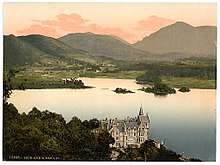Inishail
Inishail (alternate Inchald)[1] is an island and former parish,[2] in Loch Awe, Scotland.

Geography
The island lies at the north end of the loch in the council area of Argyll and Bute, between Cladich and Kilchurn. Among the group of islets near the head of Loch Awe, Inishail is conspicuous by its grassy surface, giving it the nickname "Green Isle", as the others being more densely wooded. It is situated between the Pass of Brander at the one side of the loch, and the village of Cladich on the other. [3]
History
The parish (no 512) is now part of the parish of Glen Orchy and Inishail.[2] On a slight eminence are the fragments of the walls of a small building, enclosing a space choked up with stones and a growth of nettles and other weeds; a larger space is protected from the intrusion of cattle by an iron fence.[3] This was the Chapel of St Fyndoca, and, perhaps, the remains of an ancient small convent or nunnery, though there is some dispute about its existence.[4] The convent was said to be occupied by Cistercian nuns, and the property belonging to it was erected after the Protestant Reformation into a temporal lordship in favour of Hay, who had been Abbot of Inchaffray, but later became a Protestant.[5] A burying ground has several ancient, carved tombstones, with sculptures and devices appropriate to ecclesiastics, warriors, knights, and a peer. Some grave slabs, those having figures of armed warriors and emblematical devices, may have been taken to the burial ground of Glenorchy Parish Church in Dalmally.[6] While the principal burial place of the Dukes and Duchesses of Argyll is St Munn's Parish Church, Kilmun, the 11th and the 12th Dukes chose to be buried on the island of Inishail in Loch Awe.
References
- Scottish Mountaineering Club (1913). Scottish Mountaineering club journal (Public domain ed.). The Scottish mountaineering club. pp. 72–. Retrieved 29 October 2011.
- Wilson, Rev. John The Gazetteer of Scotland (Edinburgh, 1882) Published by W. & A.K. Johnstone
- Society of Antiquaries of Scotland (1899). Proceedings of the Society of Antiquaries of Scotland (Public domain ed.). Printed for the Society by Neill and Company. pp. 48–. Retrieved 30 October 2011.
- Douglas, William (May 13, 1912). "NOTES ON THE CHURCH OF ST FYNDOCA AND ITS MONUMENTS, ON THE ISLAND OF INISHAIL, LOCH AWE". Proceedings of the Society (Public domain): 424-.
- Wilson, John Marius (1860). Nelsons' hand-book to Scotland: for tourists (Public domain ed.). T. Nelson. pp. 272–. Retrieved 29 October 2011.
- Stark, John (1831). The Scottish tourist and itinerary; or, A guide to the scenery and antiquities of Scotland and the western islands: with a description of the principal steam-boat tours (Public domain ed.). Stirling & Kenney. pp. 273–. Retrieved 29 October 2011.
| Wikimedia Commons has media related to Inishail. |
·